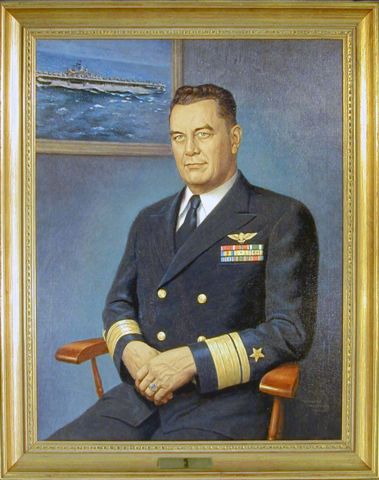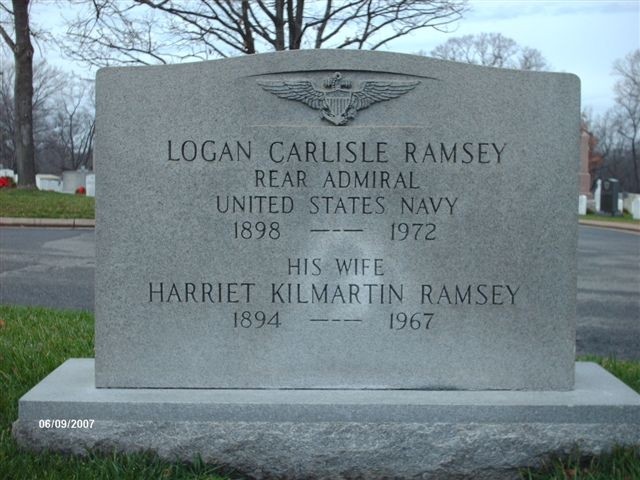Courtesy of Mary Dice Cox, January 2007:
Logan was appointed in 1914 to the U. S. Naval Academy, Annapolis, Maryland. He graduated and was commissioned Ensign in June 1918.
Logan was sent to Europe and was stationed on the USS Texas, which was one of the United States ships present at the German surrender on November 21, 1918.
In May 1941, Logan C. Ramsey, reported to Ford Island as chief of staff to Rear Admiral Patrick N. I. Bellinger, Commander of Patrol Wing Two, protecting the harbor. The two and one-half mile-long island, roughly the shape of a fat meatloaf, sat at an angle in the middle of the harbor. Officers’ quarters were grouped at the northeastern end, Admiral Bellinger’s on a small point — the Ramsey’s tropical frame house third in line. Just off the point, lay the ships of Battleship Row, seven battlewagons moored singly and in pairs, the USS Arizona teamed with the repair ship Vestal.
Testimony — given when he was captain — and taken from the Hearings before the Joint Committee on the investigation of the Pearl Harbor attack — is as follows:
“Our patrol planes covering the operation areas were carrying live depth charges and had specific orders to sink any submerged submarine sighted outside of the submarine sanctuary and without a close escort. At approximately 730 on the morning of December 7th I received a telephone call from the staff duty officer who informed me he had received a message from 14-Prep-1 (a PBY aircraft in Patrol Squadron 14) to the effect that they had sunk a submerged submarine one mile off the entrance to Pearl Harbor. I asked him if the message had been properly authenticated, because there was in the back of my mind the feeling that it was quite possible that it was a mistake, a drill message of some variety that had gotten out by accident. So I ordered the staff duty officer to request an authentication of the message immediately. However, that did not stop me from making an immediate report of the information to the staff duty officer of the Commander-in-Chief of the Pacific Fleet. I believe at the time I did not consider that as definite information of any enemy attack. I went immediately to the Command Center and for no reason that I know of, drew up a search plan for our aircraft under the conditions prevailing that day. I prepared it in dispatch form. Meanwhile, I was waiting for an authentication of this message. There was a slight delay, and approximately 5 or 10 minutes after I reached the Command Center, I saw, together with the staff duty officer, a single plane making a dive on Ford Island. The single plane appeared at the time to both the staff duty officer and myself in the light of a young aviator “flathatting” (flying low in a reckless manner) and we both tried to get his number to make a report of the violation of flight rules. He completed his dive, pulled up and away. We were commenting together on the fact that it was going to be difficult to find out who the pilot was, when the delayed action bomb which he had dropped, and which we had not seen drop, detonated, and I told the staff duty officer, “Never mind; it’s a Jap.” I dashed across the hall into the radio room, ordered a broadcast in plain English on all frequencies, “Air Raid, Pearl Harbor. This is no drill.” The detonation of the bomb dropped by that first plane was my first positive knowledge of an enemy attack.” (End of Testimony).
In 1949, Ramsey retired as a Rear Admiral, and served as Executive Vice-President of Spring Garden College, Philadelphia, Pennsylvania, for 17 years.
Logan Carlisle Ramsey was born at Jackson, Mississippi, on 26 February 1898, the son of Walter Pitman and Susan Elizabeth Fite Ramsey. He graduated from the United States Naval Academy in 1918 with the Class of 1919.
During the last six months of World War I, he served aboard the USS Texas in the British Grand Fleet.
Admiral Ramsey became a naval aviator in 1921.
When the attack was leveled at Pearl Harbor, he was Operations Officer of the Patrol Wings based in the Hawaiian Area. In May, 1942, he became Operations Officer at the island of Midway. Subsequently, he served as Chief of Staff to Commander Aircraft, Pacific Fleet. On March 8, 1943, he became the Commanding Officer of the USS Block Island CVE-21. He brought aboard some fifty survivors of an aircraft carrier that was sunk in the Pacific. He served aboard the Block Island until March 10, 1944, where he was ordered to duty as Chief of Staff to the Commander, Fleet Air, Norfolk.
Ramsey was given some 50 survivors from the USS Lexington (CV-2) which was sunk in the Coral Sea during the Battle of Midway, with the majority of the 890 sailor compliment having never previously been at sea with the majority being United States Navy Reserve. With the first two cruises of the ship scheduled for aircraft transport his job was to weld this crew into a cohesive fighting unit which was accomplished in a record time. Having been Operations Officer of the Navy Forces on the island of Midway, and later Chief of Staff to the Commander of Aircraft for the entire Pacific Fleet,
Ramsey was well qualified for this task.
Logan Ramsey Sr. retired from the Navy as a Rear Admiral and is now deceased. His son, Ensign Logan Ramsey Jr., served on CVE 106.
Captain Logan Ramsey Sr. was not new to making history. In World War II, the then Lieutenant Commander Logan Ramsey Sr. sounded the alarm at the outbreak of the Japanese attack on Pearl Harbor. He also sent this historic message out on the airways “Air Raid Pearl Harbor, this is no drill.”
The Admiral died in Delaware County, Pennsylvania, on 26 September 1972 and was buried with full military honors in Arlington National Cemetery. His wife, Harriet Kilmartin Ramsey, 18 January 1894-9 May 1967) is buried with him.
0755 hours, 7 December 1941:
At the Command Center on Ford Island, Commander Logan C. Ramsey looks out a window to see a low-flying plane. A reckless U.S. pilot, he thinks. Then he sees “something black fall out of that plane” and realizes it’s a bomb.
Ramsey runs to a radio room and orders the telegraph operators to send out an uncoded message to every ship and base: “AIR RAID ON PEARL HARBOR X THIS IS NOT DRILL.”
The coordinated attack begins as dive-bombers strike the Army Air Forces’ Wheeler Field, north of Pearl Harbor, and Hickam Field, near Ford Island’s Battleship Row. The Japanese, wanting control of the air, hope to destroy American warplanes on the ground.
Most U.S. planes have been parked wingtip-to-wingtip in neat rows to make it easy to guard them against sabotage. Most are destroyed.
RAMSEY, LOGAN C
- RADM U.S.N.
- DATE OF BIRTH: 02/26/1898
- DATE OF DEATH: 09/26/1972
- BURIED AT: SECTION 3 SITE 2091-G
- ARLINGTON NATIONAL CEMETERY
RAMSEY, HARRIET L W/O LOGAN C
- DATE OF BIRTH: 01/18/1894
- DATE OF DEATH: 05/09/1967
- BURIED AT: SECTION 3 SITE 2091-G
- ARLINGTON NATIONAL CEMETERY
Michael Robert Patterson was born in Arlington and is the son of a former officer of the US Army. So it was no wonder that sooner or later his interests drew him to American history and especially to American military history. Many of his articles can be found on renowned portals like the New York Times, Washingtonpost or Wikipedia.
Reviewed by: Michael Howard


